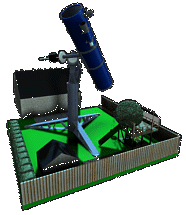 |
 |
|
Filter Research |
Go back to HOMEPAGE
 |
 |
|
Filter Research |
Go back to HOMEPAGE
|
The Human Eye The human eye is a wonderful thing. Without it there wouldn’t be much point to all this filter research I’ve been doing! Anyhoo, it is important to understand how the human eye responds to different wavelengths, and under different conditions. The retina, the part of our eye that converts light into nerve impulses, is covered in two types of receptors: the colour sensitive cones, and the non-colour sensing but more sensitive rods. Figure 3 below shows a plot of rod and cone density vs. position on the retina. Cones are located in a very narrow area at our central focus, and the rods are located over a broad region on either side of the central focus. It is easy to see from Figure 3 why the “averted vision” method of seeing faint objects works; it lines the object up with the area of peak rod density.
Figure 3 Human Eye Rod & Cone Density Distribution One fascinating feature of the eye is its ability to change what receptors it uses under different lighting conditions. In bright light our eyes capture visual data using its cone receptors, while in low light our eyes use the more sensitive rod receptors. As it happens, the sensitivity of the rods and cones to different wavelengths of light is different. As a result of this, our ability to perceive different colours (wavelengths of light) changes depending on whether our eyes are light adapted (photopic) or dark adapted (scotopic). Figure 4 is a plot of the spectral sensitivity of the human eye under these two conditions. This is an important point since the state of our eyes’ light adaptation will affect how the filters I discuss later will work. The plot also includes vertical lines marking some key emission wavelengths; these will be explained later in the chapter on Using Deepsky Filters. PDF or XLS versions of this data is available upon request. Figure 4 Human Eye Spectral Sensitivity It is interesting to note from Figure 4 that when light adapted our eyes are at peak sensitivity for the wavelengths of ionized Mercury (Hg) and Sodium (Na), not surprising then that these lamps are so popular - thus the light pollution! Also, our dark adapted eyes are at peak sensitivity for Hydrogen Beta (Hβ) and doubly ionized Oxygen (O-III) which are common wavelengths emitted by nebulae, and Acetyl (C2) which are common emission wavelengths for comet tails - how convenient! To help boil down and compare the spectral response data for the various filters there is a useful parameter called the Luminous Transmissivity. This fancy term is simply the average % of light passed by the filter across the range of visible wavelengths, from 400 to 700 nm. The average is calculated by multiplying the filter’s % transmission at each wavelength by the corresponding human eye spectral sensitivity, summing up and dividing by the number of wavelength samples (I had to figure this calculation out for myself). From what I can tell, the % transmission values quoted by manufacturers are always that corresponding to the light adapted eye. In the research I present later, I have calculated both the photopic and scotopic transmissivity, since in all likelihood I will be using these filters in the dark…duh! Now the nitty gritty, Planetary Filters… <next>
|
|
|
Introduction - The Human Eye - Planetary Filter Research - Using Planetary Filters - Deep-Sky Filter Research - Using Deep-Sky Filters - References |
Go back to HOMEPAGE
Last updated: 07-Mar-12
|
Copyrights to all content from the webpages hosted here belongs to Jim Thompson. Nov. 2009. |